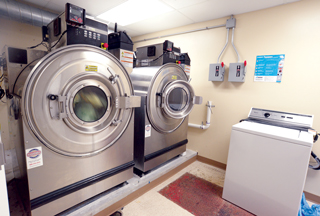
Laundry may not be the sexiest of topics in long-term care, but it is nonetheless an important — albeit sometimes overlooked — element when it comes to design, safety, and infection control efforts.
Now, as providers seek ways to better run facilities while also maintaining costs and improving quality of resident care, laundry is getting its day in the sun.
What would a component of nursing home operations be with- out the need for data? Alas, the eternal quest for useful facts and figures has made its way to laundry management, says Bill Brooks, North American sales manager for UniMac, a manufacturer of on-premises laundry equipment, with a grin.
Yes, data is the name of the game, he says, pointing to the new technology in washing and drying machines that enables them to be networked and therefore used to monitor machine performance as well as staff performance.
Data improvements
“In the past, loads were processed and cost and productivity levels were just assumed to be constants,” Brooks says. “Basically, the goal is to better use data to improve operations because managers can’t improve what they can’t measure. Some systems give managers information in real time, even from off-site.”
The bottom line is that laundry equipment manufacturers are giving nursing home laundry managers access to a wealth of operations data and this in turn helps them better manage the laundry for improved efficiency and overall quality and safety, Brooks says.
So how does laundry data happen? Washers and dryers are networked and they push the operations information to a cloud-based system.
“This makes the information accessible in real time from a secure account anywhere with an internet connection,” says Brooks. “So managers can see what machines are running, which makes it easy to question why they are not running if they are sup- posed to be.”
All of this means that machines can now measure utilization, productivity, operational and labor expenses, efficiency, cost per pound and utility expenditures.
“The data help managers better monitor performance and arms them with the knowledge to fine-tune processes to improve efficiency and quality,” Brooks
explains. “For years, the laundry has been a cost center that offered very little data on operations. Now, management can have greater visibility to ensure processes are being followed.”
What’s more, he says, we all know that what happens in the laundry department impacts the safety and comfort of residents — and staff.
Accessible ironers
Another trend in laundry management is the advent of a more accessible flatwork ironer. It was once thought of as prohibitive for myriad reasons, including cost, size, noise and the amount of heat that it releases into the working laundry — not to mention the labor involved — and it was never considered an option, says Dan Goldman, national sales manager for LaundryLux, the marketing arm for Electrolux and Wascomat commercial equipment.
“Electrolux now has compact ironers that enable automatic feeding and length folding using a patented ceramic burner assembly in which one person can finish up to 80 sheets an hour,” he says. The company highlights how automated feeding, folding and stacking cuts down on labor needs.
Plus, because ironers have drying capabilities, he says customers are selecting high-speed [450 G-force] washers and bypassing the dryer altogether for all their bedding and table linen.
“The Generation 5000 washer line has become our strongest seller as customers are looking for a high final extract,” he explains. “Some have also selected the H model for its superior dewater- ing capabilities and its effect in speeding up laundry throughput.”
Perspectives on drying equipment also are due for an update. Old tumble dryers drive up costs and are not typically touched until they are broken, notes Brooks.
“First, old units of 20-plus years of age can be inefficient, and second, over-drying loads by cranking dials as far as they can go is pretty common, given that staff members are sometimes concerned about the load being dry when they open the door.”
Brooks adds that many nursing homes are opting for tumble dryers equipped with moisture sensing technology. Such units dry to a set moisture level and then stop, which can create cost-savings in utilities and labor, and reduce wear and tear on linen.
“The exactness of the moisture reading also aids in conditioning linens before they go to the at- work ironer,” he says.
I.C. starts and stops here
The Centers for Medicare & Medicaid Services’ recent and more rigorous emphasis on infection control and prevention is driving the demand for long- term care providers to utilize laundry management systems, asserts Brooks.
“Having another check to ensure that all staff are following prescribed procedures can help identify areas where additional training is necessary, all before
a small issue becomes a larger safety problem for the patients and staff,” he says.
“They can also ensure correct cycles are being used and high water temperatures are reached, both of which are integral in the fight against the spread of infection.”
In one 2015 analysis, researchers found root causes of infection were associated with laundry equipment maintenance and operation issues, highlighting the need for maintenance and training. For example, sloppy wash-process parameter settings can trigger a greater likelihood
of microbial bacteria on laundry, they noted.
Although not likely the top consideration for infection prevention specialists, the use of chemicals and the process by which they are used can have an impact on patient health, Brooks notes.
“Bed linens and personal items that are not processed correctly, aren’t rinsed adequately and have residual laundry chemicals baked in during finishing will undoubtedly contribute to higher amounts of pressure ulcers and similar issues for patients,” he says. “This is why it is paramount to have the greatest visibility that correct processes are being followed and linens are receiving the best care. This, in turn, helps ensure the greatest care for patients and residents.”
Fighting healthcare-acquired infections is among the biggest challenges faced by providers,
and laundry is a key component in preventing the spread of infections, Goldman says. Related to this is a trend in the usage of small 30-pound washers for the processing of micro fiber mops.
“Microfiber mops have been proven to be effective in replacing the old spaghetti mops sitting in a bucket of contaminated solution,” he explains.
“The washers are being ordered with their own built-in electrical heating element, which will ensure the mops will be totally bug-free after a 160-degree final rinse.”
Design prompts changes
As the popularity and adoption of small-house models ramp up in nursing homes and other senior living settings, designing for new and remodeled spaces has become a necessity. Jane Rohde, principal at JSR Associates, a consulting and design rm based in Catonsville, Md., has been busy helping providers move from large institutional models to smaller, household models for many years. In that time, she has designed around any number of circumstances, including laundry management systems.
Rohde notes that when providers transition from institutional-based to person-centered
household models, laundry systems are forced to decentralize operations. She often walks her clients through the process via focus groups and interviews with multiple staff members.
“Laundry is a key issue for design because of the circulation and requirements that it takes for staff, as well as what it takes logistically to get to the laundry, return the laundry, fold the laundry, and place it in the appropriate location,” she explains, adding that she starts with the point of service for laundry, which is the resident’s room. “If there isn’t proper storage within a resident’s room, it has to be in a third-party space, and if it’s in a third-party space, that means the resident is at risk of falling.”
Leaving the scene
“When a resident has an accident and needs her linens changed and the linens are down the hall and the staff member needs to change the linens and help the resident, she will have to go down the hall and leave the resident alone,” Rohde continues. “So leaving someone alone who is very vulnerable, who’s had an accident, and who is probably unhappy, is a risk.
“Keeping all of the supplies at the point of service, whether it’s their clothing or linen, is one of the key conversations we have,” she adds.
In designing new, smaller models, Rohde finds that she can help providers resolve this issue by placing the laundry room on the floor within the household.
“In models that we work on, we like to suggest that family members and residents consider participating in that. You could make that laundry room like one you’d have at home, or maybe a CNA takes it out when it’s dry and gives it to a resident to fold, because that may be something they like to do,” she says.
Decentralizing the linen cleaning operations is a little different ball game.
“We always have the conversation with them about whether they have in-house operations or if they contract it out, and some people don’t realize that it can be done a different way. So just having a conversation that it can be done a little differently is helpful,” Rohde explains.
One solution she has found is placing a laundry room between two households and having the staff clean the linens at night so as not to interrupt residents’ daily activities.
“Sometimes it’s worth it for them to realize that if we don’t have to do laundry outside the household, then they don’t have to be concerned about who’s meeting them at the loading dock, who gets the linens at the loading dock, who then stores it and who is decentralizing it back to resident rooms,” she notes.
Coming clean
Rohde relayed a story about a frontline housekeeping staff member who lamented that the quality of laundry had gone down because the administrators had made a change in the detergent to save money.
“She had a resident who liked to wear her bright white shirt and she wanted to make sure her clothes were nice and clean for her,” she says. “They had changed chemicals without talking to her and it was affecting her clothing and quality of laundry.”
Rohde says she has come to learn that environmental services staff are proud of what they do and “while they’re not the highest paid and not the most respected, it’s important to understand that they’re also one of your biggest separators between infection control, cleanliness and infection rates.”
“Why the C-suites [executives] don’t get that is beyond me,” she continues, “because that’s the ticket right there.”
From the March 01, 2018 Issue of McKnight's Long-Term Care News





